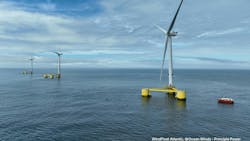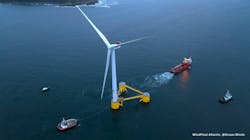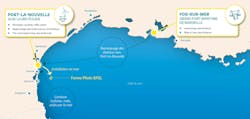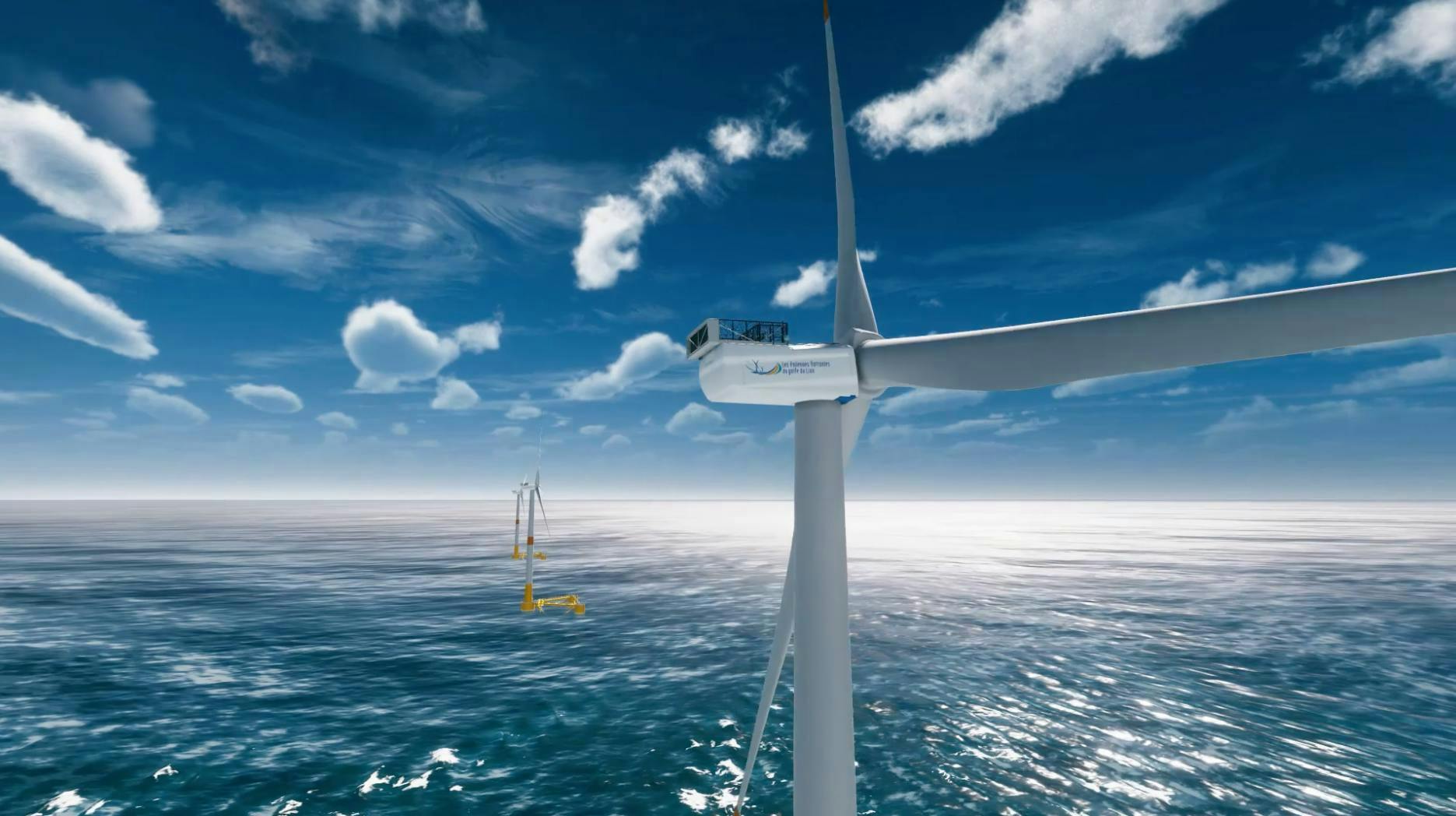WindFloat Atlantic maintaining high availability offshore Portugal
Editor's note: This feature first appeared in the March-April 2024 issue of Offshore magazine. Click here to view the full issue.
By Jeremy Beckman, Editor-Europe
WindFloat Atlantic, the semisubmersible floating offshore wind farm offshore Portugal’s west coast, is entering its fourth year of service. Ocean Winds, the joint venture between EDPRenewables and ENGIE which developed this pilot project using floaters designed by Principle Power, is now moving ahead with a second floating pre-commercial project in the Mediterranean Sea off south-west France, Eoliennes Flottantes du Golfe du Lion. Fabrication of the three floating structures is under way and installation should follow in 2024/5.
Offshore sought the views of Tiago Duarte, Head of Floating Foundations at Ocean Winds, on the innovations behind the two projects, the operating experience at WindFloat Atlantic to date, and the potential lessons for the larger-scale commercial floating offshore wind developments set to go forward later this decade.
***
Offshore: Firstly, why is Ocean Winds undertaking two pilot floating offshore wind projects?
Duarte: The decision stems from several factors. Both the Portuguese and French governments have a vision for floating wind, and each project supports the development of the industry locally with its own regulatory framework, permitting processes, and market dynamics. For Ocean Winds, this approach broadens its portfolio and reduces dependence on any single market, while creating benefits and expertise for the local stakeholders.
The different geographical locations with varying wind and sea conditions also allow the company to test the technology and assess its performance under a range of environmental factors. This provides a broader dataset for understanding how floating offshore wind systems behave in different marine environments, as well as wind and sea conditions. And running two projects concurrently accelerates the learning curve, as the company can gather data and insights more rapidly, leading to faster iterations and improvements in technology and project development practices. This accelerated learning is crucial for advancing the maturity of floating offshore wind technology in general and driving down the costs.
Each project has different procurement strategies, allowing Ocean Winds to draw learnings from a full-EPC or multi-contract approach. Furthermore, building on the project finance obtained in WindFloat Atlantic with EIB, the company was able to close project financing for EFGL with commercial banks, proofing the bankability for future commercial projects. Technology development is the last factor, as the WindFloat design has evolved from one project to the other, fostering the technology industrialization. The lessons learnt from WindFloat Atlantic have brought invaluable input to EFGL.
Offshore: Can you be more specific concerning the engineering advances?
Duarte: The current generation of WindFloat technology builds on lessons learned from previous projects and includes important innovations in modularization and manufacturability, which in turn ensure deliverability and competitiveness. For instance, the design of the columns has been simplified as well as the connections in between the columns and the bracings, reducing pre-fabrication and assembly times. Floater shape has also been optimized to accommodate the increased capacity of the latest wind turbines. Finally, the design allowed a reduction of the floater draft to suit more widely-available turbine installation ports.
Offshore: One of the stand-out design features of WindFloat Atlantic is the overall system stability in an area frequently assailed by strong winds and waves. Can you explain how this is achieved?
Duarte: The stability of the WindFloat Atlantic floating offshore wind turbines is made possible through a combination of water entrapment plates, permanent ballast and a hull trim system. The water entrapment plates are installed at the foot of the three columns of the floating platforms. These are designed to trap and retain water, effectively increasing the platform's inertia and shifting the natural periods of the structure away from the dominant wave loading. This significantly reduces the motion and loads on the floating turbines. The permanent ballast system consists of water ballast tanks located within the structure of the platform and strategically positioned to increase inertia and stability, counteracting the forces acting on the platform. Finally, the hull trim system pumps water between ballast tanks to control the platform's heel, keeping the turbine mean inclination to a minimum. This significantly reduces the loading on the structure while helping to maximize the wind energy production.
Offshore: What are the differences in the prevailing wave/wind conditions at the two sites, and how have the floaters been adapted accordingly?
Duarte: Each floater has been specifically designed taking into account the local wave and wind conditions. WindFloat Atlantic’s location is dominated by high swells from the Atlantic coast of Portugal, while the Mediterranean Sea conditions off south-western France are driven by high wind speeds when the local `Tramontane’ is blowing. The orientation of the floater is also defined to ensure the best combined turbine/floater behavior, depending on the site’s prevailing environmental conditions. The different characteristics of the two locations have led to very different floater sizes for each project. However, the site conditions are not the only inputs impacting the design, as supply chain and other constraints also influenced the basis of design.
Offshore: WindFloat Atlantic has also served as a hub for operations and maintenance advances for floating offshore wind. Can you provide some examples?
Duarte: Ocean Winds has been testing different innovation initiatives in this pre-commercial floating offshore wind project. The lessons learned and the experiences could be transferred to future commercial floating offshore wind projects around the world, giving the company and its partners a clear competitive advantage. Among the projects using WindFloat Atlantic as a test site are:
* ARIA 2: This project develops and assesses the impact of different customized satellite-based information services based on Earth Observation (EO) data, to support decision-making processes in the design and operations of offshore wind farms.
* Atlantis: Tests and demonstrates the use of key enabling robotic technologies in offshore wind farms, capable of reducing the levelized cost of energy (LCOE) by eliminating or marginalizing the use of divers and supporting vessels for inspection and maintenance operations at offshore wind farms.
* EU-SCORES: Studies the combination of wave energy converters and solar photovoltaic (PV) systems with offshore wind farms to use offshore space more efficiently and balance the electricity grid. This enables a resilient and cost-effective 100% renewable energy system.
* DigiFloat: The project aims to develop, validate and operate the world’s first digital twin software tailored to floating offshore wind applications, incorporating data from ocean buoys and onboard sensors. The digital twin model will be a real-time, high-fidelity numerical representation of the WindFloat Atlantic project, giving a greater understanding of floating offshore wind performance and operation, leading to less downtime, lower operational costs, and better predictive capabilities.
* Zelim: The primary objective is to enhance HSE protocols at floating offshore wind farms. Zelim's ZOE technology, an AI-driven software tailored for person overboard detection and real-time tracking in harsh maritime conditions, has been tested and validated at WindFloat Atlantic to assess its efficacy in bolstering safety measures and minimizing environmental risks. Zelim provides continuous monitoring of ZOE’s live feed from cameras installed on two turbine foundations.
Offshore: Another feature of this project is the operations and maintenance base onshore in Viana do Castelo. Can you outline some of the tasks that the staff perform?
Duarte: OW cloud-based systems receive real-time information from the WindFloat Atlantic floaters and turbines, enabling the operations team to track performance and proactively address potential issues that may require intervention by human technicians. Real-time data from the turbines allows the team to monitor wind speed, power generation, asset status (floater and turbine), and other performance metrics – WindFloat Atlantic closed 2023 with an electricity production for the year of 80 GWh, and has achieved more than 260 GWh cumulative since the start of operations in 2020. Additionally, real-time data from the floaters allows the team to monitor the structures’ position and movements, the hull trim system, and the intercommunication between the turbine and the floater systems.
If the performance of a turbine or a floater deviate from expected levels – indicating potential mechanical or electrical issues – the team can investigate further and schedule maintenance as needed to prevent downtime and maximize energy production. Sensors installed in the turbines and platforms continuously monitor key components such as the generator, gearbox and main bearing for signs of wear, vibration, or abnormal temperature. Any anomalies detected in the condition monitoring data trigger alerts to the operations team, who can analyze the data and take pre-emptive action to address emerging issues before they escalate into failures.
Offshore: Have there been any operational issues to date that have required remediation measures?
Duarte: Apart from regular operations and maintenance work, there have been no operational main issues. On the contrary, WindFloat Atlantic has shown outstanding performance results, surpassing expected levels of energy production. During the first three-plus years of operation, the overall monthly availability of the wind farm has been consistently above 90% on average, in several months closer to 100%, which is very significant given its floating nature and the harsh site conditions.
Offshore: Turning to the Eoliennes Flottantes du Golfe de Lion (EFGL) development, this project features three higher-output 10-MW V164 wind turbines. Has the design changed accordingly?
Duarte: Platform shape and dimensions for EFGL have been optimized to support the turbines as well as the environmental and local supply chain constraints. The different site conditions, combined with the innovations from the evolution of WindFloat design, means that we have seen a significant reduction of the overall floater specific weight per MW.
The main learnings taken from WindFloat Atlantic came from the design, construction and installation phases. Some of the different innovations applied on EFGL are improvements following experience with these phases at WindFloat Atlantic. EFGL’s team is now preparing the operation phase and remains in contact with OW Corporate and the WindFloat Atlantic team, ensuring a common understanding of the lessons obtained.
Offshore: One new feature of this project is the instrumentation that will be deployed to assess EFGL’s impact on birds. What type of information are you looking for?
Duarte: Understanding and monitoring bird behaviour is critical, in particular in the Mediterranean Sea, for the roll-out of commercial floating offshore wind projects in this region. As in WindFloat Atlantic, EFGL incorporates advanced monitoring (radar, cameras, telemetry) and will test additional deterrent technologies to mitigate risks to bird populations. This proactive approach underscores the project's commitment to responsible environmental practices.
EFGL will install a control room near the onshore substation that will transfer all data from the wind farm to the different OW control centers. In addition, EFGL will establish an Operation and Maintenance base in the Occitanie region where the team in charge of the day-to-day running and maintenance of the farm will be located.
The legacy and lessons learned from deploying two floating wind pre-commercial projects in different regions has helped advance the technology needed to reduce risk and LCOE of floating wind farms. These projects have provided important experiences in terms of different contract models and supply chains, different fabrication methods, and novel environmental monitoring techniques. This increases Ocean Winds’ confidence in continuing the development and delivering commercial-size floating wind farms in future.
About the Author
Jeremy Beckman
Editor, Europe
Jeremy Beckman has been Editor Europe, Offshore since 1992. Prior to joining Offshore he was a freelance journalist for eight years, working for a variety of electronics, computing and scientific journals in the UK. He regularly writes news columns on trends and events both in the NW Europe offshore region and globally. He also writes features on developments and technology in exploration and production.






